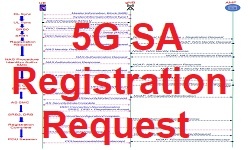5G NR – Msg2 Random Access Response (RAR) – SA Mode
In 5G NR, the initial access include down-link synchronisation and up-link synchronisation procedures. Downlink synchronisation can be achieved after decoding Minimum System Information (SSB-MIB) and Remaining System Inforatmion (RMSI- SIB 1).
After decoding SIB 1, UE get all requirement information for uplink synchronisation i.e. Random Access Procedure . Initial access RACH is a contention based (CBRA) four step procedure as shown below.

These four steps includes
- Msg1 : Random Access Preamble (RA)
- Msg2 : Random Access Response (RAR)
- Msg3 : RRC Connection Request
- Msg4 : Contention Resolution

In this post, we will discuss about Msg2 Random Access Response (RAR).
Once the UE has transmitted Msg1 RACH preamble, it does perform following procedure for Msg2 RAR
-
- UE listens the PDCCH (DCI 1_0) transmission from gNB scrambled with RA-RNTI within the period RAR-Window configured by rar-WindowLength IE in a SIB message
- UE looks for PDCCH DCI in Type 1 PDCCH Common Search Space
- Once UE is able to successful decode of PDCCH , it gets the RB resources information to receive the downlink transport block transmitted over PDSCH.
- UE tries to decode PDSCH carrying Mgs2 Random Access Response (RAR) data and check RAPID in RAR is matches with the RAPID assigned to it
- PDCCH and PDSCH transmission should be carried in same subcarrier spacing (SCS) and cyclic prefix as indicated in SIB 1.
MAC PDU for Random Access
The downlink transport block (PDSCH) contains the MAC PDU. The UE MAC PDU consists of one or more MAC subPDUs. Since multiple UEs may send a Preamble in the same RACH opportunity, they will all be addressed by the same RA-RNTI. Thus, multiple Random Access Responses (RAR) may be carried in a single MAC PDU (They correspond to different UEs that initiated the random access procedure in the same RACH opportunity).

Msg2 : Random Access Response Details

- MAC Subheaders
- E: The Extension field is a flag indicating if the MAC subPDU including this MAC subheader is the last MACsubPDU or not in the MAC PDU.
- E field is set to “1” to indicate at least another MAC subPDU follows
- E field is set to “0” to indicate that the MAC subPDU including this MAC subheader is the last MAC subPDU in the MAC PDU
- T: The Type field is a flag indicating whether the MAC subheader contains a Random Access Preamble ID or a Backoff Indicator.
- The T field is set to “0” to indicate the presence of a Backoff Indicator field in the subheader (BI)
- The T field is set to “1” to indicate the presence of a Random Access Preamble ID field in the subheader (RAPID)
- R: Reserved bit, set to “0”
- BI: The Backoff Indicator field identifies the overload condition in the cell and its size is 4 bits to represent 16 possible index. Index value and corresponding Backoff time value is shown in below table
- E: The Extension field is a flag indicating if the MAC subPDU including this MAC subheader is the last MACsubPDU or not in the MAC PDU.

- RAPID: The Random Access Preamble IDentifier field identifies the transmitted Random Access Preamble. The size of the RAPID field is 6 bits. If the RAPID in the MAC subheader of a MAC subPDU
corresponds to one of the Random Access Preambles configured for SI request, MAC RAR is not included in the MAC subPDU.
- RAPID: The Random Access Preamble IDentifier field identifies the transmitted Random Access Preamble. The size of the RAPID field is 6 bits. If the RAPID in the MAC subheader of a MAC subPDU
- MAC RAR Payload
- R: Reserved bit, set to “0”;
- Timing Advance Command: The Timing Advance Command field indicates the index value TA used to control the amount of timing adjustment that the MAC entity has to apply in TS 38.213 [6]. The size of the Timing Advance Command field is 12 bits
- UL Grant: The Uplink Grant field indicates the resources to be used on the uplink i.e. Msg3. The size of the UL Grant field is 27 bits and content of UL grant is shown in below.

-
-
- Frequency Hopping Flag
- If the value of the frequency hopping flag is 0, the UE transmits the PUSCH without frequency hopping; otherwise, the UE transmits the PUSCH with frequency hopping.
- MCS: The UE determines the MCS of the PUSCH transmission from the first sixteen indexes of the applicable MCS index table for PUSCH as described in 3GPP specification 38.214
- TPC:The TPC command value is used for setting the power of the PUSCH transmission, and is interpreted according to below table.
- Frequency Hopping Flag

- CSI request: This field a is reserved.
- Temporary C-RNTI: The Temporary C-RNTI field indicates the temporary identity that is used by the MAC entity during Random Access. The size of the Temporary C-RNTI field is 16 bits.
-
References
- 3GPP TS 38.321 5G; NR;Medium Access Control (MAC) protocol specification
- 3GPP TS 38.213 5G; NR; Physical layer procedures for control
Related Post
- 5G NR Cell Search and Synchronization
- 5G NR System Information
- 5G Master Information Block (NR-MIB)
- 5G NR System Information Type 1 (NR-SIB1)





